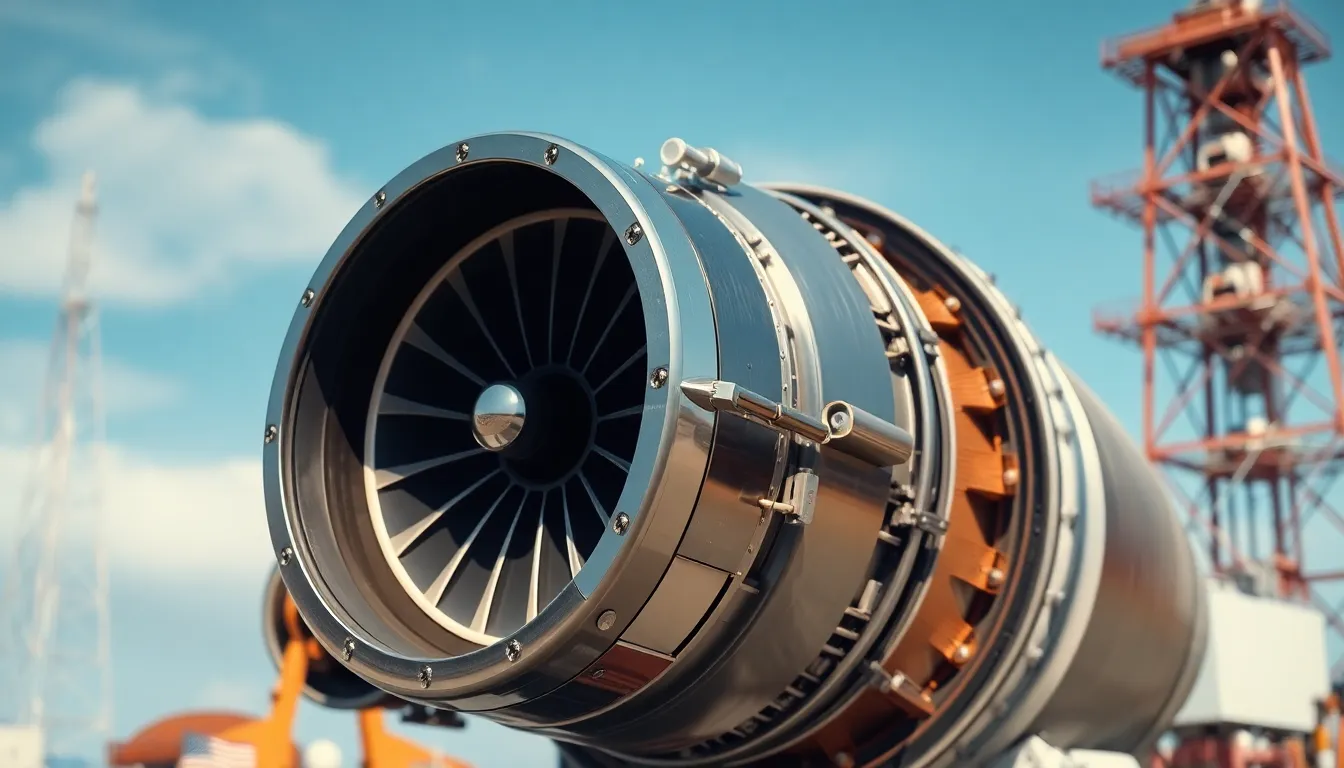In the vast universe of aerospace technology, advanced rocket systems are the shining stars. They’re not just metal tubes blasting off into space; they’re the culmination of brilliant minds, cutting-edge engineering, and a sprinkle of cosmic ambition. Imagine rockets that can not only reach the stars but also do it with the grace of a ballet dancer—if ballet dancers had engines and thrusters, of course.
These systems are revolutionizing space travel, making it more efficient and accessible than ever. From reusable rockets that make the phrase “one small step for man” a whole lot cheaper to propulsion technologies that could one day take us to Mars in a jiffy, the future of space exploration is looking brighter than a supernova. Buckle up as we dive into the fascinating world of advanced rocket systems and discover what makes them the ultimate game-changers in the final frontier.
Table of Contents
ToggleOverview of Advanced Rocket Systems
Advanced rocket systems represent a significant leap in aerospace engineering, focusing on innovations that enhance space exploration capabilities. These systems utilize state-of-the-art technologies, such as powerful engines and adaptive flight control systems, to improve performance.
Reusable rockets play a crucial role in reducing the cost of space missions, making access to orbit more affordable. SpaceX’s Falcon 9 exemplifies this innovation, showcasing how recovery and reuse can lower overall launch expenses.
Innovative propulsion technologies also contribute to advancements in speed and efficiency. Ion thrusters, for instance, use electric fields to accelerate ions, providing higher efficiency for long-duration missions. Such engines enable prolonged space travel, supporting deeper exploration missions, like those aimed at Mars.
In addition to propulsion, advanced rocket systems prioritize safety and reliability. Comprehensive testing protocols ensure these systems can withstand the extreme conditions of launch and re-entry. Organizations like NASA and ESA implement rigorous evaluation processes to validate their technologies.
Current developments in payload capacity allow these systems to carry more instruments and crew members. This growth expands existing mission profiles and enhances the potential for collaborations in research. Future projects aim to integrate even more advanced materials and techniques to optimize performance further.
Advanced rocket systems embody the future of space exploration. By merging innovative technologies with cost-effective solutions, they pave the way for more frequent and ambitious missions to outer space.
Key Technologies in Advanced Rocket Systems

Advanced rocket systems rely on several key technologies that enhance their performance and reliability in space exploration. Innovative propulsion systems play a prominent role, enabling rockets to achieve greater thrust and efficiency.
Propulsion Innovations
Propulsion innovations drive the next generation of rocket systems. Liquid oxygen and kerosene engines exemplify powerful designs, effectively powering launches. Additionally, advancements in electric and hybrid propulsion systems offer efficiency during long-duration missions. Ion thrusters represent one such development, providing continuous thrust with minimal fuel consumption. Advanced propulsion systems not only increase speeds but also improve mission flexibility, allowing for diverse payloads and extended mission durations.
Materials Science Developments
Materials science developments significantly influence the design and durability of advanced rockets. Lightweight alloys and composite materials enhance structural integrity while minimizing weight. These innovations ensure rockets endure extreme temperatures and pressures during launch and re-entry. Heat-resistant ceramics further protect engines and components, extending their operational life. Enhanced materials contribute to overall performance and safety, allowing for more ambitious missions and better payload capacities. By focusing on advanced materials, engineers optimize rocket systems for the challenges of space.
Applications of Advanced Rocket Systems
Advanced rocket systems play a crucial role in various fields, driving innovation and exploration.
Space Exploration
Space exploration benefits significantly from advanced rocket systems. These systems enable missions to distant planets and beyond. The use of reusable rockets is transforming how missions are conducted, allowing for multiple launches at reduced costs. Advanced propulsion technologies, like ion thrusters, provide greater efficiency for long-duration missions. Agencies like NASA and private companies, such as SpaceX, utilize these systems to reach ambitious objectives, including crewed missions to Mars. Increasing payload capacities also facilitate more extensive scientific research, fostering international collaborations. Overall, these innovations are key to expanding human presence in space and exploring the unknown.
Military Uses
Military applications of advanced rocket systems enhance defense capabilities. These systems support satellite deployment for intelligence and communication purposes. Precision-targeting mechanisms improve the effectiveness of military operations, enabling accurate strike capabilities. Enhanced propulsion systems increase the speed and maneuverability of missile technologies. Nations invest in these technologies to maintain strategic advantages in global security. The adaptability of these systems allows for diverse applications, ranging from surveillance to transport. As military needs evolve, advanced rocket systems continue to shape modern defense strategies.
Challenges Facing Advanced Rocket Systems
Advanced rocket systems encounter several significant challenges that impact their development and deployment. Cost and funding issues, along with technical limitations, present ongoing hurdles in the quest for innovation and efficiency.
Cost and Funding Issues
Funding advanced rocket systems often proves challenging. High development costs can deter investors and government agencies. Programs like NASA’s Artemis require billions of dollars, making budget approval critical. Private companies also face financial constraints, as sustained investment is necessary for research and development. Competing priorities within government budgets can limit support for ambitious space projects. Moreover, costs associated with materials and technology development can escalate quickly, which raises concerns about financial feasibility for long-term missions. Addressing these funding issues is essential for the next generation of exploration technologies.
Technical Limitations
Technical limitations hinder the potential of advanced rocket systems. Efficiency in propulsion systems can be less than optimal, impacting fuel consumption and overall mission duration. Reliability remains a concern, as failures in critical systems can jeopardize missions. Existing technologies may lack the versatility required for various mission profiles, limiting their applications. The challenge of developing lightweight materials while ensuring structural integrity persists, as existing materials often cannot withstand extreme conditions. Overcoming these technical barriers remains vital to achieving the goals of future space exploration and enhancing military capabilities.
Future Trends in Advanced Rocket Systems
Emerging technologies are shaping the next generation of advanced rocket systems, emphasizing the importance of sustainability. Reusable rocket technology is a focal point, with companies like SpaceX demonstrating its effectiveness through successful launches and landings. Innovations in propulsion are also gaining traction, reflecting efforts to enhance performance while minimizing environmental impact.
Electric propulsion systems are on the rise, providing higher efficiency for long-duration space missions. Developments in hybrid engines show promise for achieving faster speeds without sacrificing reliability. Continued investment in materials science leads to lighter, stronger materials that improve rocket durability and performance.
Space agencies and private companies recognize the value of increased payload capacities. Expanding these capabilities allows for larger instruments and crew deployments, fostering collaboration on scientific research missions. Meanwhile, distributed sensor networks built from small satellite systems support global communication and data collection.
Safety and reliability remain top priorities. Comprehensive testing protocols play a crucial role, ensuring that advanced systems can withstand the challenges of space travel. Higher automation levels enhance operational precision, reducing human error and enabling more efficient mission planning.
International collaborations are becoming more common in the realm of space exploration. Agencies like NASA partner with private firms, pooling resources and expertise to tackle ambitious objectives, including crewed missions to Mars. Military applications also evolve, as advanced rocket systems offer enhanced capabilities for defense operations.
Challenges persist, particularly concerning funding and technological hurdles. High development costs continue to pose obstacles, requiring strategic investment plans. Addressing issues of propulsion efficiency and developing adaptive designs are essential steps in overcoming existing limitations. The future of advanced rocket systems hinges on innovation, collaboration, and overcoming these challenges for continued progress in space exploration.
Advanced rocket systems are paving the way for a new era in space exploration and defense. Their innovative technologies are not just enhancing efficiency but are also making space more accessible than ever before. As the industry continues to evolve with reusable rockets and advanced propulsion, the potential for ambitious missions grows.
While challenges like funding and technical limitations remain, the focus on sustainability and collaboration is driving progress. The future of these systems is bright, promising more frequent missions and groundbreaking discoveries. With continued investment and innovation, advanced rocket systems will undoubtedly shape the next chapter of humanity’s journey into the cosmos.





